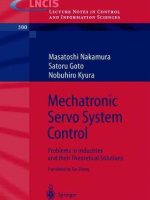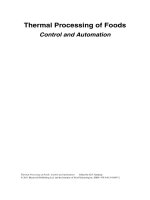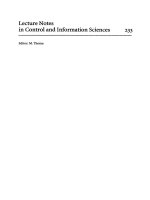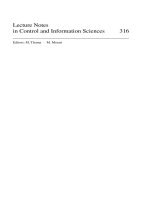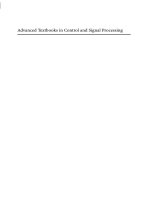Lecture Notesin Control and Information Sciences ppt
Bạn đang xem bản rút gọn của tài liệu. Xem và tải ngay bản đầy đủ của tài liệu tại đây (9.93 MB, 186 trang )
Lecture Notes
in Control and Information Sciences
233
Editor: M. Thoma
Pasquale Chiacchio and Stefano Chiaverini (Eds)
Complex
Robotic
Systems
~ Springer
Series Advisory Board
A. Bensoussan • M.J. Grimble • P. Kokotovic
H. Kwakernaak • J.L. Masse)"
Editors
Dr Pasquale Chiacchio
Dr Stefano Chiaverini
Dipartimento di Informatica e Sistemistica,
Universith degli Studi Napoli Federico II,
Via Claudio 21,1-80125 Napoli, Italy
ISBN 3-540-76265-5 Springer-Verlag Berlin Heidelberg New York
British Library Cataloguing in Publication Data
Complex robotic systems. - (Lecture notes in control and
information sciences ; 233)
1.Robotics
I.Chiacchio, Pasquale II.Chiaverini, Stefano
629.8'92
ISBN 3540762655
Library of Congress Cataloging-in-Publication Data
A catalog record for this book is available from the L~rary of Congress
Apart
from any fair dealing for the purposes of research or private study, or criticism or review, as
permitted under the Copyright, Designs and Patents Act 1988, this publication may only be
reproduced, stored or transmitted, in any form or by any means, with the prior permission in writing
of the publishers, or in the case of reprographic reproduction in accordance with the terms of
ticences issued by the Copyright Licensing Agency. Enquiries concerning reproduction outside those
terms should be sent to the publishers.
© Springer-Verlag London Limited 1998
Printed in Great Britain
The use of registered names, trademarks, etc. in this publication does not imply, even in the absence
of a specific statement, that such names are exempt from the relevant laws and regulations and
therefore free for general use.
The pubnsher makes no representation, express or impUed, with regard to the accuracy of the
information contained in this book and cannot accept any legal responsibility or liability for any
errors or omissions that may be made.
Typesetting: Camera read)" by editors
Printed and bound at the Athenmum Press Ltd., Gateshead, Tyne & Wear
6913830-543210 Printed on acid-free paper
No' si volta chi a stella ~ fisso.
Leonardo da Vinci
Preface
The challenges that mankind must face in this era of astonishing progress
in technology calls for the development of a common and up-to-date world-
wide knowledge base. When working at this book our intention was to
realize a small contribution to the achievement of this goal within the field
of Robotics.
Robotic systems have proven themselves to be of increasing importance
and are widely adopted to substitute for humans in repetitive and/or haz-
ardous tasks. Their diffusion has outgrown the limits of industrial appli-
cations in manufacturing systems to cover all the aspects of exploration
and servicing in hostile environments such as undersea, outer space, battle-
fields, and nuclear plants.
Complex robotic systems, i.e. robotic systems with a complex structure
and architecture, are gaining increasing attention from both the academic
community and industrial users. The modeling and control problems for
these systems cannot be regarded as simple extensions of those for tradi-
tional single manipulators since additional complexity arises: to accomplish
typical tasks there is the need to ensure coordinated motion of the whole
system together with management of interaction between each component
of the system.
This book focuses on two examples of complex robotic systems; namely,
cooperating manipulators and multi-fingered hands.
In April 1997 we organized a Tutorial Session on these topics at the
IEEE International Conference on Robotics and Automation held in Albu-
querque, NM, collecting contributions from distinguished scientists through-
out the world. The collected material was of high quality and up-to-date,
thus we thought it could be of interest to a wider audience. Therefore, we
asked all the contributors to further extend their manuscripts; all of them
agreed and the result of this joint effort is this book.
Although the book is the outcome of a joint project, the individual
contributions are attributed as detailed in the following. We feel the need
to thank our colleagues for their motivation during the project.
vii
viii Preface
In Chapter 1, Masaxu Uchiyama gives a general perspective of the state
of the art of multi-arm robot systems. After outlining the historical evolu-
tion of studies in this area, he gives the fundamentals of kinematics, statics
and dynamics of such systems.
Chapter 2 has been written by John T. Wen and Lee S. Wilfinger. They
extend the manipulability concept commonly used for serial manipulators
to general constrained rigid multibody systems. The concepts of unstable
grasp and manipulable grasp are also introduced.
In Chapter 3 we present the kinematic control approach for a dual-
arm system. An effective formulation is presented which fully characterizes
a coordinated motion task, and a closed-loop algorithm for the inverse
kinematics problem is developed. A joint-space control scheme based on
kineto-static filtering of the joint errors is devised and analyzed.
Michael A. Unseren in Chapter 4 reviews a method for dynamic load
distribution, dynamic modeling, and explicit internal force control when
two serial link manipulators mutually lift and transport a rigid object. A
control architecture is also suggested which explicitly decouples the two set
of equations comprising the model.
Ian D. Walker devotes Chapter 5 to a survey of design, analysis, and
control of artificial multi-fingered hands and corresponding research in the
area of machine dexterity. An extensive bibliography is also provided.
In Chapter 6 Friedrich Pfeiffer presents optimal coordination and control
of multi-fingered hands for grasping and regrasping. The method is applied
to an experimental setup consisting of a hand with hydraulically driven
fingers which ensure good force control.
The book is addressed to graduate students as well as to researchers in
the field. We hope they will find it useful and fruitful.
Napoli, Italy, September 1997
Pasquale Chiacchio, Ste/ano Chiaverini
Contributors, in chapters' order, are: Masaru Uchiyama, Tohoku Univer-
sity, Japan; John T. Wen and Lee S. Wilfinger, Rensselaer Polytechnic
Institute, U.S.A.; Pasquale Chiacchio and Stefano Chiaverini, Universit/~
di Napoli Federico II, Italy; Michael A. Unseren, Oak Ridge National Labo-
ratory, U.S.A.; Inn D. Walker, Clemson University, U.S.A.; Friedrich Pfeif-
fer, Technische Universit£t M/inchen, Germany.
Contents
Multi-arm robot systems: A survey 1
1.1 Introduction 1
1.2 Dynamics of multi-arm robots 3
1.3 Derivation of task vectors 6
1.3.1 External and internal forces/moments 7
1.3.2 External and internal velocities 8
1.3.3 External and internal positions/Orientations 9
1.4 Hybrid position/force control 10
1.5 Load sharing 11
1.6 Practical implementation 13
1.7 Advanced topics 18
1.7.1 Multi-flexible-arm robots 18
1.7.2 Slip detection and robust holding 22
1.8 Conclusions 26
References 27
Kinematic manipulability of general mechanical systems
33
2.1 Introduction 33
2.2 Differential kinematics and static force model 35
2.2.1 Differential kinematics 35
2.2.2 Force balance 39
2.3 Velocity and force manipulability ellipsoids 41
2.3.1 Serial manipulators 41
2.3.2 Velocity ellipsoid 42
2.3.3 Force ellipsoid 45
2.3.4 Configuration stability and manipulability 47
2.3.5 Internal force and virtual velocity 48
2.4 Illustrative examples 48
2.4.1 Simple two-arm example 48
2.4.2 Planar Stewart platform example 50
ix
CONTENTS
3
4
2.4.3 Six-DOF Stewart platform example 53
2.5 Effects of arm posture and bracing on manipulability 55
2.5.1 Effect of arm posture 55
2.5.2 Effect of bracing 59
2.5.3 Effect of brace location 62
2.5.4 Effect of brace contact type 63
2.6 Comparison of manipulability ellipsoids 66
2.7 Conclusions 73
References 76
Kinematic
control of dual-arm systems
3.1
3.2
3.3
3.4
3.5
3.6
3.7
79
Introduction 80
Cooperative task description 81
Differential ldnematics 83
Inverse kinematics algorithm 85
Cooperative system modeling 87
Joint space control 89
3.8
3.9
References
Stability analysis 91
3.7.1 Imperfect compensation of gravity terms 92
Addition of a force loop 94
Conclusions 95
95
Load distribution and control of interacting manipulators
99
4.1 Introduction 100
4.2 System description and dynamics 102
4.2.1 System variables and coordinate frames 102
4.2.2 Manipulator dynamics 104
4.2.3 Object dynamics 105
4.3 A general framework for load distribution 106
4.3.1 Identifying motion inducing and internal stress com-
ponents of (~ Y) 108
4.3.2 Choosing matrix M 109
4.4 Modeling of ldnematic coupling effects 112
4.5 Derivation of rigid body model in joint space 114
4.6 Reduced order model 117
4.7 Control architecture 120
4.8 Conclusions 121
References 123
CONTENTS xi
6
Multi-fingered hands: A survey 129
5.1 Robot hand hardware 129
5.2 Key issues underlying multifingered manipulation 132
5.2.1 Contact conditions and the release of constraints . . 133
5.3 Ongoing research issues 134
5.3.1 Grasp synthesis 134
5.3.2 Grasp stability 135
5.3.3 The importance of friction 136
5.3.4 Finger force distribution issues 137
5.3.5 Varying contacts: Rolling and sliding 139
5.3.6 Kinematics of rolling contact 139
5.3.7 Grasp compliance and control 141
5.4 Further research issues 143
5.5 Current limitations 144
5.6 Conclusions 145
References 145
Grasping optimization and control 161
6.1 Introduction 161
6.2 Grasp strategies 163
6,3 The TUM-hydraulic hand 168
6.3.1 The design 168
6.3.2 Measurement and control 169
6.4 Examples 172
6.5 Conclusions 175
References 177
Chapter 1
Multi-arm robot systems:
A survey
This chapter presents a generM perspective of the state of the art of multi-
arm robot systems which consists of multiple arms cooperating together on
an object. It presents first a historical perspective and, then, gives funda-
mentals of the kinematics, statics, and dynamics of such systems. Definition
of task vectors highlights the contents and gives a basis on which cooper-
ative control schemes such as hybrid position/force control, load sharing
control, etc. are discussed systematically. Practical implementation of the
control schemes is also discussed. Implementation of hybrid position/force
control without using any force/torque sensors but with exploiting motor
currents is presented. Friction compensation techniques are crucial for the
implementation. Lastly, the chapter presents a couple of advanced topics
such as cooperative control of multi-flexible-arm robots and robust holding
with slip detection.
1.1 Introduction
It was not late after the emergence of robotics technologies that multi-arm
robot systems began to be interested in by some of robotics researchers.
In the early 1970's, they had Mready started research on this topic. The
reason was apparent, that is, due to many limitations in applications of the
single-arm robot; the single-arm robot can carry only smM1 objects that can
be grasped by its end-effector, needs auxiliary equipments in assembly tasks
and, therefore, is not suited for applications in unstructured environments.
Examples of research work in the early days include that by Fujii and
Chapter 1, Multi-arm robot systems: A survey
Kurono [1], Nakano
et aI.
[2], and Talmse
et al.
[3]. Already in those pieces
of work have been discussed important key issues in the control of multi-
arm robots: master/slave control, force/compliance control, and task space
control. Nakano
et al.
[2] proposed master/slave force control for the co-
ordination of the two arms to carry an object cooperatively. They pointed
out the necessity of force control for cooperative multiple robots. The force
control is discussed also in [4]. Kurono presented the master/slave control
in [5] earlier than Nakano
et al.
[2], incidentally. Fnjii and Kurono's pro-
posal in [1] is compliance control for the coordination; they defined a task
vector with respect to the object frame and controlled the compliance that
was expressed in the coordinate frame. Interesting features in the work by
Fujii and Kurono [1] and also by Tal~se
et al.
[3], by the way, are that
both of the work implemented force/compliance control without using any
force/torque sensors; they exploited the back-drivability of the actuators.
The importance of this technique in practical applications, however, was
not recognized at that time. More complicated techniques to use precise
force/torque sensors lured people in robotics.
In the 1980's, having had theoretical results for the single-arm robot,
strong research on the multi-arm robot was renewed [6]. Definition of task
vectors with respect to the object to be handled [7], dynamics and control of
the closed-loop system formed by the multi-arm robot and the object [8], [9],
and force control issues such as hybrid position/force control [10], [11] have
been explored. Through the research work, strong theoretical background
for the control of the multi-arm robot is being formed, as is described below,
and giving basis for research on more advanced topics, such as cooperative
control of dual flexible arms, or development of practical implementation.
How to parameterize the constraint forces/moments on the object, based
on the dynamic model for the closed-loop system, is an important issue to
be studied; the parameterization gives a task vector for the control and,
hence, an answer to one of the most frequently asked questions in the field
of multi-arm robotics, that is, how to control simultaneously the trajectory
of the object, the contact forces/moments on the object, the load sharing
among the arms, and even the external forces/moments on the object.
Many researchers have challenged solving the problem; force decomposi-
tion may be a key to solving the problem and has been studied by Uchiyama
and Dauchez [12], [13], Walker
et al.
[14], and Bonitz and Hsia [15]. Param-
eterization of the internal forces/moments on the object to be intuitively
understood is important. Williams and Khatib have given a solution to
this [16]. Cooperative control schemes based on the parameterization are
then designed; they include hybrid control of position/motion and force
[121, [13], [171, [181, [19], and impedance control [201, [21 I.
Load sharing among the arms is also an interesting issue on which many
1.2. Dynamics of multi-arm robots
papers have been published
[221, [23], [24], [25], [26].
The toad sharing is
for optimal distribution of the load among the arms. Also, it may be
exploited for robust holding of the object when the object is held by the
arms without being grasped rigidly. In both cases, anyhow, it becomes a
problem of optimization and can be solved by either heuristic methods [27]
or mathematical methods [28], [29].
In practical implementation, sophisticated equipments such as force/
torque sensors tend to be avoided in industry by many reasons: unreliability,
expensiveness, etc. Rebirth of the early methods by Fujii and Kurono
[1], or by Inoue [30], should be attractive for people in industry. Hybrid
position/force control without using any force/torque sensors but using
motor currents at the joints is being successfully implemented in [31]. A
key technique in the work is compensation of the friction at the joints.
Recent reseaxch is focused on more advanced topics such as handling
of multi-bodied objects, or even flexible objects [32], [33], [34], [35]. Also
cooperative control of multi-flexible-arm robots is an advanced topic of
interest [36], [37]. Once modeling and control problem is solved, the flexible-
arm robot is a robot with many merits [38]: it is of light-weight, compliant,
and hence safe, etc. Robust holding of the object in presence of slippage
of end-effectors on the object may be achieved if the slippage is detected
correctly [39].
The rest of the chapter is organized as follows: In Section 1.2, dynamics
formulation of closed-loop systems consisting of a multi-arm robot and an
object is presented. In Section 1.3, the constraint forces/moments on the
object derived in Section 1.2, are elaborated; they are parameterized by ex-
ternal and internal forces/moments. In Section 1.4, a hybrid position/force
control scheme that is based on the results in the previous section, is pre-
sented, followed by load sharing control methods discussed in Section 1.5.
Consideration on practical implementation is given in Section 1.6. Ad-
vanced topics being presented in Section 1.7 are mainly those of research
in the author's laboratory. This chapter is finally concluded in Section 1.8.
1.2 Dynamics of multi-arm robots
Let suppose the situation depicted in Figure 1.1 where two arms hold a
single object. The arms and the object form a closed kinematic chain and,
therefore, equations of motion for the system is easily obtained. A point
here is that the system is an over-actuated system where the number of
actuators to drive the system is more than the number of degrees of freedom
of the system. Therefore, how to deal with the constraint forces/moments
acting on the system becomes crucial. Here, we formulate those as the
Chapter 1. Multi-arm robot systems: A survey
J
//~/ F~,/~ F,, Fh2
~1 Zh2
hl ~ "- Xa ~'a "ra "~ ~ Yh2
T'hl ~ ~/
//
T~h2
Nh I r ff
N,, Nh 2
Figure 1.1: Two arms holding an object.
forces/moments that the arms impart to the object.
A model for the analysis that we introduce here is a lumped-mass model
and a concept of virtual stick. The virtual stick concept was originally
presented in kinematics formulation [12], [13]. The object is modeled as a
point with mass and moment of inertia, and the two arms holds the point
through the virtual sticks. The point has the same mass and moment of
inertia as the object and is located on the center of mass. The model is
illustrated in Figure 1.2 with definitions of the frames S~ and S~ that will
be used later in this chapter. With this modeling the formulation becomes
straightforward.
Let denote the forces and moments at the point acting on the object
through the arm i as fi, then, the forces and moments reacting on the arm
through the object is -fi, and the equations of motion of the arm i is given
by
Mi(Oi) Oi +
Gi(0i, 0i) = T, +
J~(Oi)
(-f,) (1.1)
where
Oi
is a vector of the joint variables, T~ is a vector of the joint torques
or forces,
Mi(Oi)
is an inertia matrix,
Gi(Oi, 0~)
represents the joint torques
or forces due to the centrifugal, Coriolis, gravity, and friction torques or
forces at the joints. J~(0~) is the Jacobian matrix to transform the joint
velocity 0i into the velocity of the frame Z~ at the tip of the virtual stick.
Another factor to influence the dynamics of the system is that of the
object which in this case is obtained as one for a rigid body. Supposing
the position and orientation of the object be represented by a vector p~,
we have the following equation of motion:
Mo(q~)~ + Go(dp,~) = fl + f2
(1.2)
1.2. Dynamics of multi-arm robots 5
Figure 1.2: A lumped-mass model with virtual sticks.
where ¢ is a vector to represent orientation angles of the object, Mo(¢) is
an inertia matrix of the object, and Go(C, (~) represents nonlinear compo-
nents of the inertial forces such as gravity, centrifugal, and Coriolis forces.
The geometrical constraints imposed on the system come from the fact
that the two arms hold the object. Let denote the position and orientation
of the object calculated from the joint vector of the arm i as Pi, and suppose
that the vector is given by
p~ = Hi(e~). (1.3)
Since the object is rigid, the constraints are represented by
p~ = H1(01) = H2(e2) (1.4)
where p~ represents the position and orientation of the object.
Now, we have a set of fundamental equations to describe the dynamics
of the closed-loop system, that consists of the differential equations (1.1)
and (1.2) to describe the dynamics of the arms and the object, respectively,
and the algebraic equation (1.4) to represent the constraint condition.
The system of equations forms a singular system and the solution is
obtained as follows [8]: The differential equations (1.1) and (1.2) are written
by one equation as
M(q) (t + G(q, 4) = 7" + jT(q)A
(1.5)
where
M(q)
is the inertia matrix of the whole system,
G(q, q)
represents
the nonlinear components of the whole system, q is a vector of generalized
Chapter 1. Multi-arm robot systems: A survey
coordinates that consist of the joint variables of the arms and the posi-
tion and orientation of the object, ~- represents the generalized forces, and
J(q)
is a Jacobian matrix. )~ represents constraint forces/moments. The
constraint condition (1.4) is written in a compact form as
H(q) = O.
(1.6)
Combining Equations (1.5) and (1.6), we have
M(q) 0 7"-
jT(q)A
H(q)
] . (1.7)
It is noted that the matrix in the left side of the equation is singular and
hence direct integration of Equation (1.7) is impossible, of course.
The solution of Equation (1.7) is obtained after the reduction trans-
formation as follows [8]: Differentiating the constraint condition twice by
time, we have
[-I(q) = J(q)~l
+ J(q)//= 0. (1.8)
Since
M(q)
in Equation (1.5) is positive definite, its inverse exists and we
have
~= M(q) -1 {'r +
jT(q),~-G(q,q)},
(1.9)
Substituting Equation (1.9) into Equation (1.8), we have
J(q)M(q)-ljT(q).~ = J(q)
[M(q) -1 {G(q, q) - T}] - .I(q)q.
(1.10)
Therefore,
A = { J(q)M(q)-ljT(q)}-1
{j(q)[M(q)_ 1 {G(q,//)- "r}] - J(q)//}.
(1.11)
From Equations (1.9) and (1.11), we obtain q and ~, that is the solution
for a given r.
It is noted that the inverse kinematics problem of flexible-arm robots
is formulated as a problem of finding a solution for a set of differential-
algebraic equations [40]. The problem may be mathematically similar to
the one in this section.
1.3 Derivation of task vectors
The task vector consists of a set of variables that is convenient for describing
a given task. A set of Cartesian coordinates in the workspace forms a task
1.3. Derivation of task vectors 7
vector for a task of carrying an object in the workspace, for example. For
more complicated tasks that include constrained motion, it has to be defined
not only as position/orientation of the object but also as forces/moments
acting on the object. In this section, we derive task vectors to describe a
task performed by the multi-arm robot.
The constraint forces/moments
fi
are those applied to the object by
the arm i and are obtained from Equation (1.11) when the joint torques or
forces -ri are given. Since fi is 6-dimensional, the forces/moments applied
to the object by the two arms are altogether 12-dimensional, six of which are
for driving the object, and the rest of which do not contribute to the motion
of the object but yield internal forces/moments on the object. Noting this
intuition, we derive the task vector for the cooperative two arms [12], [13],
[24].
1.3.1 External and internal forces/moments
First, the external forces/moments on the object are defined as those to
drive the object. That is,
Io
= /1+/2
: t,0 i0 [fl
= (1.12)
where W is a 6 x 12 matrix with range of 6-dimension and null space of
6-dimension. I,~ is the unit matrix of n-dimension. This relation is shown
in Figure 1.3 (a). A solution for A when fa is given is
A : W+fa +
(I12 -
W+W) z
= W+f~ +
[I6
-I6] Tf~
= W+f~ + Vfr
(1.13)
where W + is the Moore-Penrose inverse of W given by
W + = 116 . (1.14)
z is an arbitrary vector of 12-dimension. The second term of the right
hand side of Equation (1.13) represents the null space of W, and V rep-
resents its bases by which the vector fr is represented. The relation is
shown in Figure 1.3
(b).
It is apparent when viewing V that f~ repre-
sents forces/moments being applied by the two arms in opposite directions.
8
Chapter 1. Multi-arm robot systems: A survey
Constraint forces/moments
vector space
W
External forces/moments
ce
R 12
(a) External forces/moments
Constraint forces/moments
vector space
,6
.t
es/moments
ce
t~ R 6
(b) Internal forces/moments
Figure 1.3: External and internal forces/moments.
We call the forces/moments represented by f~ internal forces/moments.
Solving Equation (1.13) for f~ and f~, we have
f~ = f~ + f2 (1.15)
1
f~
= ~
(fl
-
f2). (1.16)
1.3.2
External and internal velocities
The velocities corresponding to the external and internal forces/moments
are derived using the principle of virtual work, as follows:
1
sa
= 5 (Sl + s2) (1.17)
Asr : sl - s2 (1.18)
where s~, Asr, Sl and s2 are velocity vectors corresponding to f~, f~, fl
and f2, respectively. The velocities s~, sl and s2 are those of Z~, ~1 and
E~ in Figure 1.2, respectively.
1.3. Derivation of task vectors 9
1.3.3 External and internal positions/orientations
The positions/orientations corresponding to external and internal forces/
moments are derived by integrating the relation in Equations (1.17) and
(1.18), as follows:
1
P~ = ~ (Pl + P2) (1.19)
Ap~ = p~ - m (1.20)
where p~, Apt, Pl and P2 are position/orientation vectors corresponding
to s~, st, Sl and s2, respectively. The positions/orientations
p,, Pl
and
P2 are those of S~, $1 and $2 in Figure 1.2, respectively.
An alternative way of representing the positions/orientations is to use
the homogeneous transformation matrix [24]: The positions and orienta-
tions of the frames $1 $2 in Figure 1.2 is represented by
H~=[
TMO
oi0 a~0 X~]l " (1.21)
Corresponding to the positions/orientations p, and
Ap~,
the homogeneous
transformation matrix to represent the position/orientation of the frame
Za:
Ha=[ naO Oao aao :Ca
(1.22)
and the vectors
Axe, A~
to represent the small (virtual) deformation of
the object are derived as follows:
1
n~ = ~ (nl + n2) (1.23)
1
o~ = ~ (ol + 02) (1.24)
1
a~ = ~ (al + a2) (1.25)
1
:co = ~ (:ci + :c2) (1.26)
A:C~. = :cl x2 (1.27)
A~r = £ (n2 x nl + 02 x ol + a2 x al). (1.28)
2
10
Chapter 1. Mudti-arm robot systems: A survey
1.4 Hybrid position/force control
In the previous section we have seen that the task vectors for the coop-
erative two arms are the external and internal forces/moments, velocities,
and positions/orientations. The internal positions/orientations are con-
strained in tasks such as carrying a rigidly held object. Therefore, a cer-
tain force-related control scheme should be applied to the control of the
cooperative two arms. There have been proposed different schemes for the
force-related control. They include compliance control [1], hybrid control of
position/motion and force [10], [11], [12], [13], [17], [18], [19], and impedance
control [20], [21]. Any of those control schemes will be successfully applied
to the control of this system if the task vector is properly chosen. For those
systems that this chapter deals with and in which constraint conditions are
clearly stated, however, hybrid position/force control will be most suitably
used. The rest of this section, therefore, describes the hybrid position/force
control [12], [13], [17].
Using the equations derived
hybrid position/force control are
z=[
u=[
h=[
in Section 1.3, the task vectors for the
defined as
p~ Ap T IT (1.29)
]T (1.30)
]T
where z, u, and h are the task position, velocity, and force vectors, re-
spectively. The organization of the control scheme is shown in Figure 1.4,
diagrammatically. The suffixes r, c and m represent the reference value,
current value and control command, respectively. The command vector e~
to the actuators of the two arms is calculated by
e~ = ez + eu (1.32)
where ez is the command vector for the position control and is calculated
by
e~ = Kz J-~IGz(s)SB~ (z~ - z~) (1.33)
and eu is the command vector for the force control and is calculated by
eh -= gh JTGh(S)(I S) (h~ - he). (1.34)
B~ in Equation (1.33) is a matrix to transforra the errors of orientation
angles into a rotation vector. Je is the Jacobian matrix to transform the
joint velocity ~ = [0T ~T] T into the task vector of velocity u. G~(s)
1.5. Load sharing
11
0~
Zcl_ "'" l Zc," O~l ~ ,
hr~~~+ ~r s~m~ V
Ec
4 l" I_ ,
L
-I h~ 4- ~ j- ~c
Figure 1.4: A hybrid position/force control scheme.
and
Gh(s)
are operator matrices representing position and force control
laws, respectively. The matrices Ks and
gh
are assumed to be diagonal.
Their diagonal elements convert velocity and force commands into actuator
commands, respectively. S is a matrix to switch the control modes from
position to force or vice versa. S is diagonal and its diagonal elements take
the values of 1 or 0. The ith workspace coordinate is position-controlled if
the ith diagonal element of S is 1, and force-controlled if 0. I is the unit
matrix with the same dimension as S. 0c and Ac are vectors of measured
joint variables and measured forces/moments, respectively.
In the above control scheme, without distinguishing a master nor a
slave, the two arms are controlled cooperatively. It is not necessary to
assign master and slave modes to each arm. Also, in the control of internal
forces/moments, since the references to the external positions/orientations
are sent to the both arms, the disturbance from the position control loop
to the force control loop is decreased. This enables the above scheme to
achieve more precise force control than the master/slave scheme [11], [17].
1.5 Load sharing
The problem of load sharing in the multi-arm robot system is that of how to
distribute the load to each arm; a strong arm may share the load more than
a weak one, for instance. This is possible because the multi-arm robot has
redundant actuators; if the robot has only suificient number of actuators
for supporting the load, no optimization of load distribution is possible. In
this section, we elaborate this problem according to our previous work [24],
[27], [28], [29]. Also, it should be noted that the work by Unseren [25], [26]
is more comprehensive.
12
Chapter 1, Multi-axm
robot
systems: A survey
We can introduce a load-sharing matrix in the framework presented in
Section 1.3. By replacing the Moore-Penrose inverse in Equation (1.13) by
a generalized inverse, we obtain:
where
), = w-lo + vf' (1.35)
IT
W- = [ K T (I6- K) T
(1.36)
The matrix K is the load-sharing matrix. We can prove easily that the
non-diagonal elements of K only yield a A vector in the null space of W,
that is, the space of internal forces/moments. Therefore, without loosing
generality, let us choose K such that:
K = diag [a~] (1.37)
where we call a~ a load sharing coefficient.
Now, the problem we have to deal with is that of how to tune the load
sharing coefficient a~ to ensure correct manipulation of the object by the
two arms. To answer this question, we have to notice first that by mixing
Equations (1.13) and (1.35), we obtain:
fr = V-1 (W- - W +) f~ + f'r (1.38)
which, by recalling that only fa and ~k are really existing forces/moments,
notifies that:
• f~, ft and a~ are "artificial" parameters introduced for better un-
derstanding of the manipulation process.
• fP~ and a~ are not independent quantities. The concept of internal
forces/moments and the concept of load sharing are mathematically
mixed with each other.
Therefore, we can conclude that to tune the load sharing coefficients or
to choose suitable internal forces/moments is strictly equivalent from the
mathematical and also from the performance point of view. One of f~,
fP, and ai is independent parameters, that is redundant parameters, to
be optimized for load sharing. This is more generally stated in [25], [26].
We have proposed to tune the internal forces/moments f~ for simplicity of
equations and also for consistency with control [28], [29].
One of interesting problems regarding the load sharing is that of robust
holding: a problem to determine the forces/moments A, which the two arms
apply to the object, in order not to drop it even when disturbing external
1.6. Practical implementation
13
forces/moments are applied to it. This problem can be solved by tuning
the internal forces/moments (or the load sharing coefficients, of course).
This problem is addressed in [27], where conditions to keep holding are
expressed by the forces/moments at the end-effectors, and Equation (1.35)
being substituted into the conditions, a set of linear inequalities for both
f'~ and a~ are obtained as:
Af~ + B(~ < c (1.39)
where A and B are 6 × 6 matrices, c a 6-dimensional vector, and a =
[al, a2, , a6] T. In the paper [27], a solution of a~ for the inequality is
obtained, heuristically. The above inequality can be transformed into that
with respect to f,, of course, but the parameter a~ is fitter to such heuristic
algorithm because a~ can be understood intuitively.
The same problem may be solved mathematically: introducing an ob-
jective function to be optimized, we can formulate the problem as that
of mathematical programming. For that purpose, we choose a quadratic
function of f~ as
rain fTQI r (1.40)
where Q is a 6×6 positive definite matrix. The objective function represents
a kind of energy to be consumed by the joint actuators; the arms consume
electric energy in the actuators to yield the internal forces/moments f,.
The problem to minimize the objective function under the constraints is a
quadratic programming problem. A solution can be found in [28], [29].
1.6 Practical implementation
The results regarding the topics of this chapter that the researchers have
yielded so far are of value, of course, but not being used in industry. Why
are they not being used? A reason will be that the schemes require sophisti-
cated force/torque sensors and special control software that is incompatible
to current industrial robots. Therefore, we re-examine the control scheme
that we presented in the previous sections so that it may be used in industry.
A solution will be that we should use motor currents to get force/torque
information instead of wrist force/torque sensors. This technique was pro-
posed first long time ago [30].
To see if this solution is feasible, we implement the hybrid position/force
control scheme in Section 1A by a robot developed for experimental re-
search on application to shipbuilding work [31]. The robot is called C-
ARM (Cooperative-ARM) and is drawn in Figure 1.5. Each arm has three
degrees-of-freedom in the same vertical plane. The first joint is a prismatic
14
Chapter
1. Multi-arm
robot
systems: A survey
X~t
Figure 1.5: An experimental two-arm robot.
one, and the second and the third are rotary. Every joint is actuated by
an AC servo motor. The torque 7-,,i at the ith joint is proportional to the
motor current I~i, that is:
r,~i = Kti I~
(1.41)
where
Kti
is a constant of proportionality for the motor. Using this prop-
erty, we realize cooperative control without using any force/torque sensors
but measuring the motor currents only.
Generally, the motor torques at each joint are amplified by the reduction
gears. The amplified torques are represented by
K~7",~ = r v + v/ (1.42)
where K~ is a diagonal matrix with the reduction gear ratios as its diagonal
elements, 7" m is a motor torque vector, ~'v is a torque vector to move the
arms, and ~rf is a torque vector corresponding to the forces/moments on
1.6. Practical implementation
15
+ Rsi
I./"
/+E i
-Rsi
Figure 1.6: A friction model.
the end-effectors. The term K~r,~ is obtained by measuring the motor
currents.
Now, a question arises: how can we get only ~-f from the measured
values of the motor currents? To answer this, we need to derive equations
of motion for the robot with considering even the dynamics of its motors and
the reduction gears. Neglecting the inertia terms due to the link dynamics
in the equations of motion, we obtain
~-p = r~ + r 9 (1.43)
where r~ and 1" 9 are the friction and the gravity force vectors, respectively.
Then, ~-p is deducted from the joint torque KrT"m, to yield ~-f, which in
turn is used to calculate the forces/moments being applied to the object,
and hence external and internal forces/moments on the object.
The friction model used for the calculation of ~-~, is shown in Figure 1.6.
This model includes both Coulomb and viscous frictions. In Figure 1.6, Oi
and R,~ are the joint angle and the maximum static friction, respectively,
while ei is a constant parameter which is a threshold for the approximation
of 8i to be zero. Here, since it is difficult to decide the direction and
magnitude of the static friction, we propose a novel method in which static
friction is switched alternately between +R,~ and -R~ at each sampling
period At. In this case, the friction of each joint ~-~{ is written as follows:
rv{
I
v~ O~ + Rc~ sgn( O~ )
-e~ < 0i <_ e~
(1.44)
where Vi and Rci are the coefficients of viscous and Coulomb frictions,
respectively.
16
Chapter 1. Multi-arm robot systems: A survey
500
r,',,n
400
S
300
Current
Reference
I , I ,b I ,- [ , , I
2 4 6
Time [s]
Figure 1.7: Experimental results: °xa.
On applying the hybrid position/force control scheme, we find the robot
has three external and three internal degrees of freedom. In the experiment,
the external and internal coordinates are controlled by position- and force-
control modes, respectively. For reference positions/orientations, those at
the object center is used, and for reference forces/moments, the internal
forces/moments on the object are taken.
Experimental results are shown in Figures 1.7-1.10. The reference po-
sitions/orientations are given as a cosine curve in x direction, and the ref-
erence internal forces/moments are all set to be constant. To see if the
internal forces/moments calculated from the motor currents give good es-
timation, we compared those with the internal forces/moments measured
by a force/torque sensor embedded in the object. The "Sample" in Fig-
ure 1.9 and 1.10 means that the force data are obtained by the force/torque
sensor. As to the internal forces, large vibrations in the controlled values
are observed when the object velocity approaches to zero. These vibra-
tions are caused by the static friction determined by Equation (1.44). The
forces measured by the force/torque sensor, however, are held close to the
reference values during the whole task. This shows that our method works
well.
